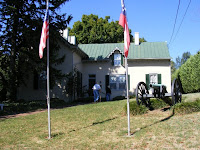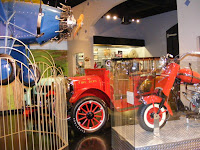And now, on to the cowboys.
After staying the night in the
Will Rogers Inn (and having breakfast at Eggberts, which seems to be a regional or local chain), we headed up to the
Will Rogers Memorial Museum. The museum is actually located in two buildings: the Museum itself, and the Will Rogers home in Oologah, Oklahoma, where Will was born.

At bit of background: Will Rogers was one of the people who defined "cowboy" and "The West" through movies, rodeo shows, and other media. He was born in 1879, never managed to finish a formal education, and made a name for himself with his riding and rope tricks as a young man. He started performing in vaudeville theaters, then signed on for the Broadway show Ziegfeld Follies in 1915. He went on to become a successful newspaper writer, a radio star, and an actor. In 1935 he and another man attempted to fly from Alaska to Russia, but crashed into a lake 15 miles from their intended pit stop.

When we pulled into the museum parking lot, the first thing we noticed were the three school buses parked at the far end. Sure enough, there seemed to be about five hundred kids from local elementary schools wandering around the museum displays (and, of course, the gift shop). They were reasonably well behaved, but of course, they're kids....
We did catch part of a live talk from one of the museum staff, who portrayed Will Rogers for the kids and did do several rope tricks as he talked. He also showed a black-and-white film Rogers had done, demonstrating a whole bunch of rope tricks using riders, horses, and other moving targets.

The museum rooms held a variety of items, including many saddles, part of Rogers' collection. (At left is Will Rogers' son's boyhood saddle.) He apparently picked these up all over the world; some seem to have been gifts.
One room had six display cases and a large mural. The cases represented one aspect of Rogers' career: his Broadway show, his newspaper work, his films, and his roping, among others. One whole room was a reproduction of his ranch in California. Rogers ended up owning the ranch on which he was born, but he also spent a fair amount of time in New York City and California. Below is a brief video of the ranch room. You can hear the schoolkids in the background.
After the museum, we drove out to the family farm, which consists of a house, a barn, an outhouse, and a lot of fencing. The caretakers have an assortment of anim

als on the farm, including a couple of donkeys and some goats.
The house, pictured at right. Rooms include bedrooms, a parlor, kitchen, and attic.

At left is the brand Rogers chose for his ranch and cattle. It's actually modeled after an object called a dog iron, which holds logs in the fireplace. Hence the name "Dog Iron Ranch". This picture was taken of the brand on the front steps of the house.

The barn was built using period techniques and materials. (The original was destroyed by wildfires, as were a couple of replacements.) Around 10,000 head of cattle live on the ranch at various times during the year, but only a few animals use the barn.
Continuing with our theme of "cowboys", we drove on to Bartlesville, Oklahoma, and then over the Dewey, the home of the
Tom Mix museum. (Official website can be found
here.) Another

rider and actor who helped define "The West", Mix starred in more than 300 films. He was born in northwestern Pennsylvania in 1880(the two people staffing the museum said at least two towns have been listed as his birthplace in various records) and moved to Oklahoma in 1909. Most of the display items belong to Mix at one time or another, and were saved by a friend after Mix's death in 1940 in an automobile accident (what is it with these cowboy icons dying in accidents?).
A few of Mix's movies are shown while the museum is open. We caught a 10-minute segment at a special showing, since the movies are shut off at 3:30 or so, and we were there a little after 4 p.m. Flash photography is discouraged in a lot of places like this, so I only have one shot of the building itself.
Outside Bartlesville is the
Woolaroc Museum, which houses an enormous c

ollection of Western art and Native American items. As usual, there were buses of schoolkids everywhere. The area was nice, and the collection was impressive, but we were kind of expecting a wildlife sanctuary, and got a game preserve instead. Apparently the owner, Oklahoma oilman Frank Phillips, imported a lot of exotic animals and they of course needed to be kept in fenced

enclosures. The Phillips family lived here beginning in 1927.
The name "Woolaroc" comes from the
woods,
lakes and
rocks that make up the ranch acreage. The lodge is pictured at right. Above are some of the local wildlife we happened to see.
I have mostly pictures of the ground

s, as photos are discouraged inside the museum and lodge. So I'll leave you with a few photos, as I close out the cowboy section of the trip. For now....

(
Currently reading: The Wild Road, by Gabriel King. It's not about the West, it's a fantasy novel about cats.)
 ost expensive tourist destinations north of Disney World. (Although admittedly in better taste.)
ost expensive tourist destinations north of Disney World. (Although admittedly in better taste.) Three stories plus parts of the basement are open to the public, and for once we were allowed to take photos, as long as the flash was turned off. So I can show you the pictures, and let them mostly speak for themselves.
Three stories plus parts of the basement are open to the public, and for once we were allowed to take photos, as long as the flash was turned off. So I can show you the pictures, and let them mostly speak for themselves.














































